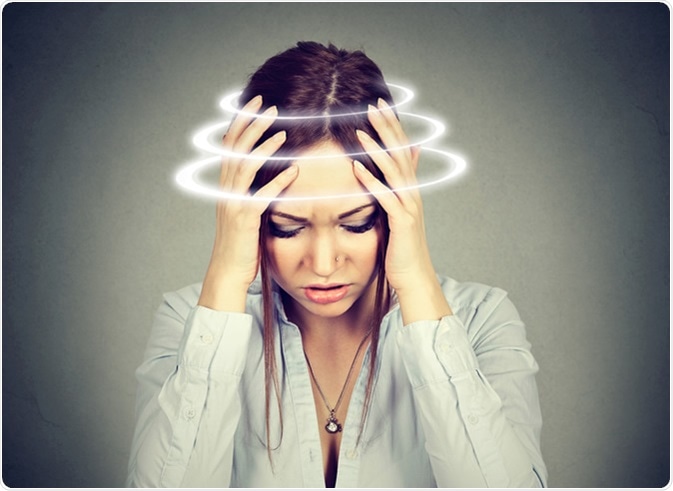Skip to:
Vertigo is a sensation of spinning or dizziness often caused by a mismatch of the brain’s visual, vestibular, and sensory information systems. Apart from dizziness, there are issues with balance, motion sickness, nausea and vomiting, headache, and feeling of fullness in the ear. Vertigo can also be a symptom of other conditions.
There are 2 types of vertigo - peripheral vertigo and central vertigo.

Image Credit: Pathdoc / Shutterstock
Peripheral vertigo
Peripheral vertigo is the most common type of vertigo and is caused by problems in the inner ear, which controls our balance. It presents with symptoms such as spinning sensation, sweating, nausea, vomiting, and ear problems. If peripheral vertigo is due to an infection in the inner ear, there can be pain or feeling of fullness in the ear.
Causes of peripheral vertigo
Benign paroxysmal positional vertigo (BPPV) is the most common form of peripheral vertigo. This type of vertigo is easy to treat and hence correct diagnosis avoids unnecessary testing and costly treatment. BPPV is characterized by short-lived episodes of rotatory dizziness along with head movements. The usual time frame is nearly 45 seconds.
Vestibular neuritis causes a monophasic episode of vertigo that lasts for days or even weeks in worst cases. In the acute phase, it is usually accompanied by severe nausea & vomiting.
Ménière's disease is another cause of peripheral vertigo and is a result of endolymphatic regulatory dysfunction. Spells of dizziness usually last for hours, and are often preceded by pressure or fullness in the ear. High salt intake might make matters worse.
Trauma can also cause many types of vertigo including BPPV.
What Is Benign Paroxysmal Positional Vertigo?
How is peripheral vertigo treated?
Peripheral vertigo can be treated using drugs and medication such as antibiotics (in case of infections), antihistamines, prochlorperazine to relieve nausea, and anxiety medications such as benzodiazepines. Meniere’s disease patients are often given medication to help reduce inner ear pressure and relieve symptoms. Vestibular neuritis can be treated with very short courses of vestibular suppressants such as diazepam and lorazepam.
In treating BPPV, the Epley maneuver and Brandt-Daroff exercises that involve a series of guided head movements have been found to be helpful. Any hearing loss or ringing in the ears is treated using medication and hearing aids. A low salt diet, diuretic medications, and alcohol abstinence can help in recovery.
Central vertigo
Central vertigo is mostly caused by injury to the brain or brain disease. Central vertigo usually comes without much warning and also lasts for longer periods of time compared to peripheral vertigo. It is also more intense than episodes of peripheral vertigo and patients may need help to walk or even stand up.
Causes of central vertigo
Transient ischemic attack (TIA) and brainstem infarction are important causes of central vertigo as ischemia in the brainstem can be life threatening. As with all strokes and TIAs, traditional vascular risk factors for this condition include diabetes, hypertension, and hyperlipidemia. This type of vertigo presents with dizziness spells accompanied by diplopia, numbness, and lack of coordination. Patients usually present with vertigo, diplopia, ipsilateral ataxia, and ipsilateral loss of pain sensation on the face.
Tumor or mass in the brainstem causes vertigo along with symptoms such as progressive unilateral hearing loss.
Multiple sclerosis is another significant cause of central vertigo in younger patients. Nearly 33% of MS patients present with visual symptoms and about 7% of patients present with vestibular symptoms.
Migraine causes episodic vertigo that lasts a few minutes to hours in about 10-30% of patients.
How is central vertigo treated?
Central vertigo can only be managed by diagnosing the root cause of the vertigo and treating it. Migraines can usually be treated with prophylactic migraine medications. In case of multiple sclerosis and tumors, managing the symptoms with medicines for nausea and dizziness usually helps.
New type of vertigo
Apart from peripheral and central vertigo, neurologists recently identified a new type of vertigo which had no known cause but responds to treatment. This condition is known as recurrent spontaneous vertigo with head-shaking nystagmus. Patients with this condition had vertigo attacks accompanied by headaches, nausea, and vomiting. These patients were also more likely to experience severe motion sickness than patients with other types of vertigo.
Further Reading